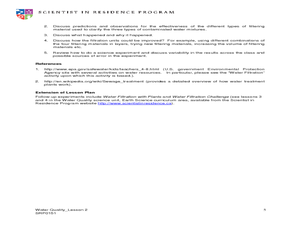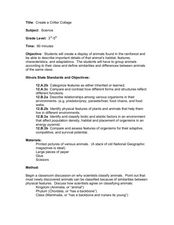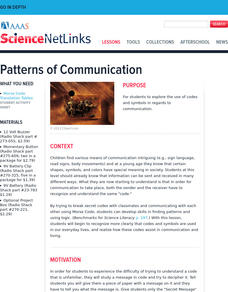Curated OER
Water Quality: Water Filtration
Learners build a water filtration system. In this water quality lesson, students work in groups to construct water filtration units that can purify contaminated water. This lesson is part of a larger unit on water quality.
Curated OER
Magnets
Second graders classify objects and create hypotheses regarding their magnetic properties. They watch a video about magnets and finally use a magnet to test their hypotheses created earlier.
Curated OER
Create a New Animal
Students understand what physical adaptations are and how they help an animal to survive. In this adaptations lesson, students research four animals and then make an original animal that has adaptations to make them survive.
Curated OER
Fun With Adhesives
Learners observe, measure, and record the properties in making objects stick together using science tools. In this science lesson, students explore with their senses while mixing flour and water. Additionally, learners share their...
Curated OER
Mendelian and Non-Mendelian Heredity
Tenth graders discuss their physical features, and why they look the way they do. They listen as the teacher discusses DNA, alleles, and dominant or recessive genes. Students perform an experiment with different colored markers...
Curated OER
Ooblek
Learners demonstrate the three states of matter. In this matter lesson, students read Bartholomew and the Ooblek. Learners create "ooblek" and discuss what state of matter it is.
Curated OER
Water Cycle Bag
Students enclose water in an airtight bag and leave it in a warm area to view the water cycle. In this water cycle lesson plan, students observe evaporation, condensation, and precipitation. They then discuss what they learned about the...
Curated OER
Human Anatomy- How Do We Move?
Students examine the muscular system. In this muscular system lesson, students first draw a realistic representation of their leg or arm bones. Students do several activities to attach these bones to "joints" with string to simulate...
Curated OER
Mineral Identification
In this mineral identification lesson plan, learners analyze 14 minerals and test their physical properties. They test the color, luster, streak, hardness and breakage of each mineral. Students answer 5 questions about the physical...
Curated OER
Create a Critter Collage
Young scholars create a collage. In this animal classification lesson, students discuss why and how scientists classify animals. Young scholars view pictures of different animals and decide which class each animal belongs to. Students...
Curated OER
Water Resource Engineering
Learners examine solubility and the significance of water. In this aqueous solution lesson students complete a lab activity on soil profiles.
Curated OER
Sink or Float?
Students will determine whether various objects sink or float in water. They do not need to explain why objects sink or float. They are rather to be encouraged to observe that the same objects will sink or float every time, i.e., that...
Curated OER
Sorting
Students understand that sorting helps find things at a later date. In this sorting lesson, students use a website game and sort the common items. Students sort folders and other classroom items. Students discuss how sorting helped them...
Curated OER
Designing "Green" to Save Our Green Planet
Young scholars design an environmentally friendly home. In this middle school math/science lesson plan, students watch videos on creating green design. Young scholars work in collaborative groups to determine what makes a...
Curated OER
Creating a Simple Telegraph Machine
Students experiment and discuss circuits and how they work. In this science lesson, students construct a telegraph machine using cardboard, wires, battery, electric tape and masking tape. They investigate what happens as the circuits...
Curated OER
Solar Cells
Students are able to answer basic questions about the process of turning light energy into electrical energy. They are introduced to the basic physics and chemistry behind the operation of a solar cell. Students explore how a single...
Curated OER
Layers of the Earth: Plate Tectonics
Sixth graders participate in a lesson that is about investigating the different layers of the earth and defining how the plates move over the mantle. They engage in a variety of activities and use mathematics to create projects to...
Curated OER
So You Think You're Tough
Fourth graders learn how to classify animals. In this invertebrates lesson plan, 4th graders discuss how we classify thinks into groups and move into a discussion about classifying animals. Students learn about the differences between...
Curated OER
What happens to water before we use it?
Students examine how water is treated prior to becoming available for human consumption. In this water treatment lesson plan, students conduct an experiment in which they filter water. Students formulate a hypothesis, test, analyze data,...
Curated OER
Influential Scientists Vocabulary Quiz
In this science vocabulary worksheet, learners match the names of 19 science professionals with the definition. Example: Ichthyologist (studies fish).
Curated OER
Genetics and Heredity: The Next Generation
Tenth graders work in teams to order events of DNA transcription and translation protein synthesis. In the second lesson, they put the steps of mitosis and meiosis in order using a concept map poster. They use modeling clay to create...
Curated OER
The Periodic Table of the Elements
Learners research the elements used to create fireworks. In this periodic table lesson, students discuss common metals, their characteristics, and their places on the periodic table. They work in small groups to research the elements...
Curated OER
Pressures and Responsibities
Students recognize some of the physical dangers of smoking. They discuss personal responsibilities regarding smoking and peruse magazines and newspapers to find at least one tobacco advertisement.
Curated OER
ChromaCool!
Fifth graders watch a video about physical and chemical changes. In groups, they participate in a variety of activities involving color. They write their observations in a journal. To end the lesson, they use a checklist to classify...

























